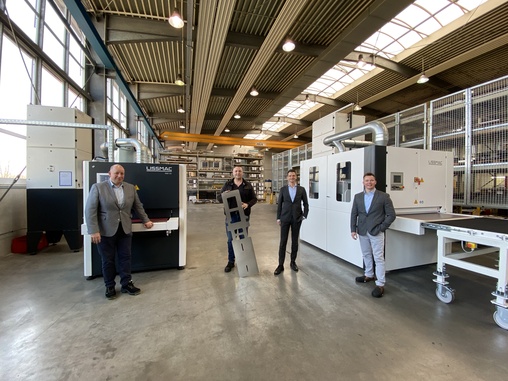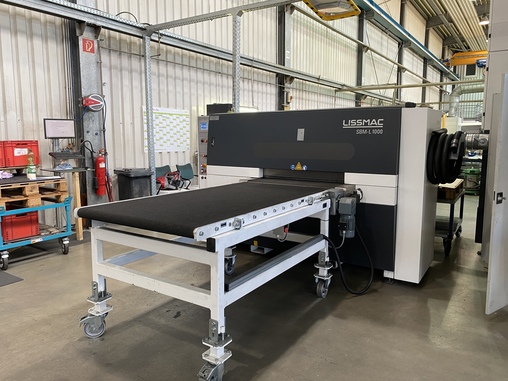
Restructuring in companies is often associated with new acquisitions. A sheet metal processor from Salching in Lower Bavaria invested in new deburring and grinding technology. And in view of the company’s realignment, one planned new plant became a package of three plants in total. Now efficiency and comprehensive flexibility are ensured.

© Lissmac
Until March 2019, Sturm Blechverarbeitung was part of the Sturm Group, a global player in the fields of automation technology, materials handling, surface technology and vision technologies. With an investor investment, Sturm Blechverarbeitung then became independent and an independently operating company as of April 2019. It has already had a sales volume of around 30 million euros for several years.
Roland Lukas, Commercial Managing Director of Sturm Blechverarbeitung GmbH, always looks at the figures in the light of strategic and technical future requirements. “A complex future-oriented investment plan was set up with the new investors. A new hall was added to make the complete flow from laser part to assembly efficient. In addition, the product portfolio was to be rounded off and assemblies with assembly were to be increasingly offered. Since then, laser edge parts have been produced for this purpose. Deburring and straightening are essential topics in this context with regard to quality. And automation was another point that was to be improved,” he summarizes.
With the implementation of various measures, which also included the new acquisition of plant technology, growth of 10 to 20 percent is to be achieved in the next few years as part of the realignment, and the workforce is also to be increased somewhat. Against this background, the first step was to procure a replacement for existing, already older deburring machines.
In addition, the automation or the new Stopa sheet metal rack storage system at the laser line now achieved a large parts throughput that could no longer be handled with manual labor and was to be absorbed. What was needed was new and efficient plant technology that could be integrated into these processes.
Alexander Luft, head of finishing at Sturm Blechverarbeitung, had the task of defining which plant and performance requirements were to be implemented with the new technology in order to meet the increased material throughput that had arisen and the associated increase in productivity as well as the company’s realignment.

© Sturm sheet metal processing
The desired package of machine equipment
“We wanted to become more flexible in machining different geometries and dimensions of the products. The increasing requirements for surface grinding and edge breakage, i.e. injury-free geometries, are also very important as a quality feature for our customers. And last but not least, the employees were to be relieved in the processing of small parts,” says Luft, naming some of the requirements.
Accordingly, the starting point was the consideration of the new acquisition of a small parts grinding machine. Since many small parts in credit card format were still processed in large quantities with hand-operated grinding machines at Sturm Blechverarbeitung, efficiency was to be created here. The decision was made in favor of an SBM-XS from Lissmac Maschinenbau, which is suitable for deburring both sides and uniform edge rounding of punched as well as laser- and fine plasma-cut workpieces with dimensions from 25 x 25 x 1 mm to 200 x 200 x 15 mm in just one operation.
At an on-site appointment in Bad Wurzach, Alexander Luft and the technical managing director Reinhold Schultes were able to take a closer look at this system as well as the SMD1 and SMD3 deburring machines. “We basically wanted to achieve more independence with regard to the geometry size of the parts to be machined. That’s why these two systems were also interesting for us,” he adds.
In particular, the SMD 335 was able to score points with the users of Sturm Blechverarbeitung. It is versatile: for deburring, edge rounding, finishing and oxide layer removal as well as for small part machining regardless of the part geometry. On the Powergrip belt, on which the parts lie during processing, they are fixed by the high adhesive force without magnet or vacuum. In addition, the belt is continuously wet-cleaned so that the operator always has a clean contact surface. In addition, the system offers possibilities for automation and integration into a production line.
Dry grinding technology was new to Sturm Blechverarbeitung, as wet grinding had previously been used. “With this system, however, better edge breakage, better surface quality and also a greater throughput can be realized than with the existing machines. The service life of the abrasive is also significantly longer,” says Luft, citing some of the advantages.
Of course, finding the right equipment supplier beforehand was a challenge. The infrastructure also had to be created. This means that the space had to be available and the utilities had to be connected. And last but not least, it was also important to find the right personnel to operate the equipment. When looking for the equipment supplier, Lissmac was immediately the company of choice, says Alexander Luft looking back.

© Lissmac
Convinced with the first order
The first joint order was realized by Sturm Blechverarbeitung and Lissmac in spring 2019. And it was a tough one, because it included some very important and quite critical parts that were to be processed with a planned new plant. Therefore, in advance and with a view to current orders, it was important to select the relevant parts for test machining: from thin sheet to thick sheet, from pointed to round, as well as different materials.
“We manufacture the parts, which are of very high quality, for an important B2B project. Efficiency should be increased in any case. And the customer expects 100 percent performance here, i.e. no complaints. A photo-optical detection system developed in-house helps to implement the high level of quality and process required,” says Luft, summarizing the requirements.
Alexander Bochtler, Area Sales Manager at Lissmac, recalls: “The component in question was originally machined in four to sometimes five steps. The stainless steel part was to be machined on a new system with high quality and at a lower cost. The burr should be removed as evenly as possible in one pass, and the edge should also be properly rounded rather than just slightly broken to eliminate the risk of injury during subsequent assembly.”
These corner points are important in terms of appearance and feel, but also for further processing, because they protect the punch and die during folding, for example.
Alexander Bochtler, who knows his company’s machines and the work results that can be achieved with them, agreed to reduce the machining process to just one pass after inspecting the parts. The initial skepticism of the customer Sturm was apparent, but then quickly dispelled, because the test machining of the critical components was convincing.
The delivery of the SBM-L, a system for deburring and edge rounding of workpieces up to 50 mm sheet thickness on both sides, marked the beginning of a reliable partnership. The dry machining system for simultaneous machining of the inner and outer contours saves cost-intensive turning of the workpieces or repeated machining of the parts. The new technology was delivered and put into operation in October 2019. The first order, the machining of the critical stainless steel parts, was realized without any problems. “The be-all and end-all in such a collaboration is that the promised results are also delivered,” Alexander Luft sums it up.
Author: Annedore Bose-Munde
